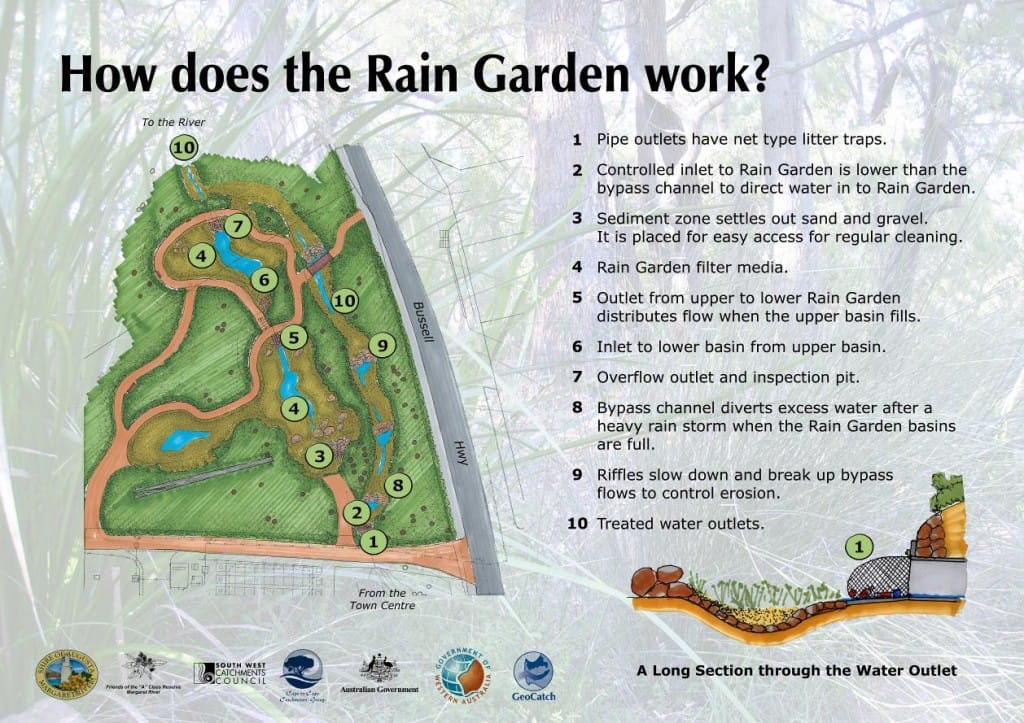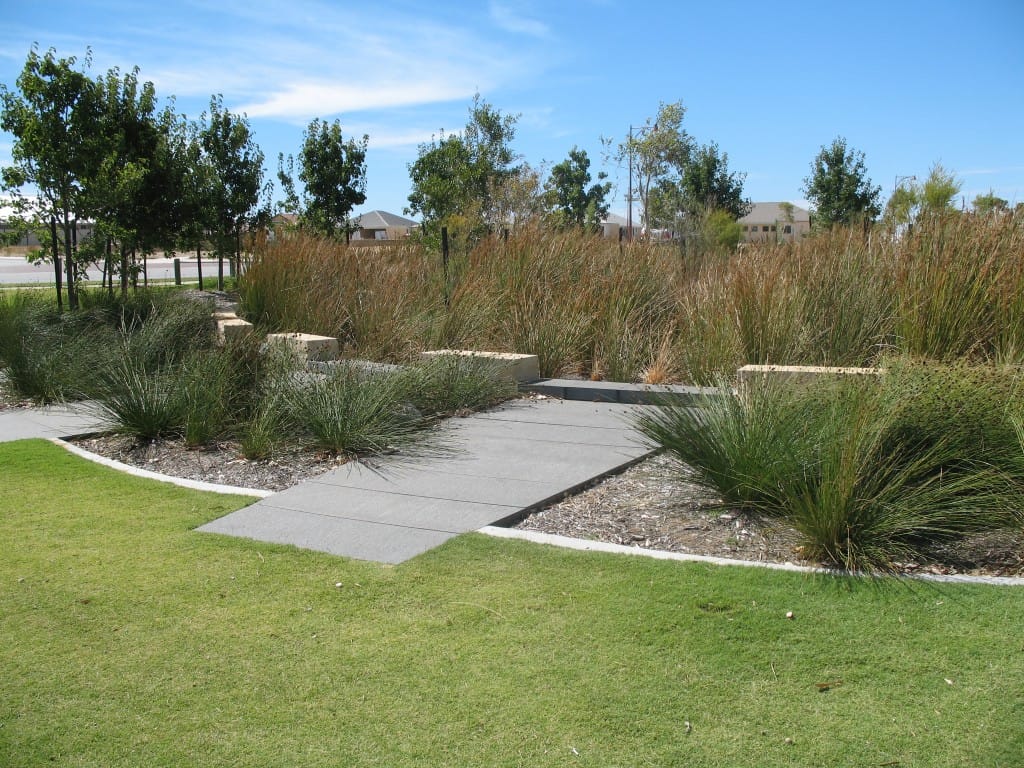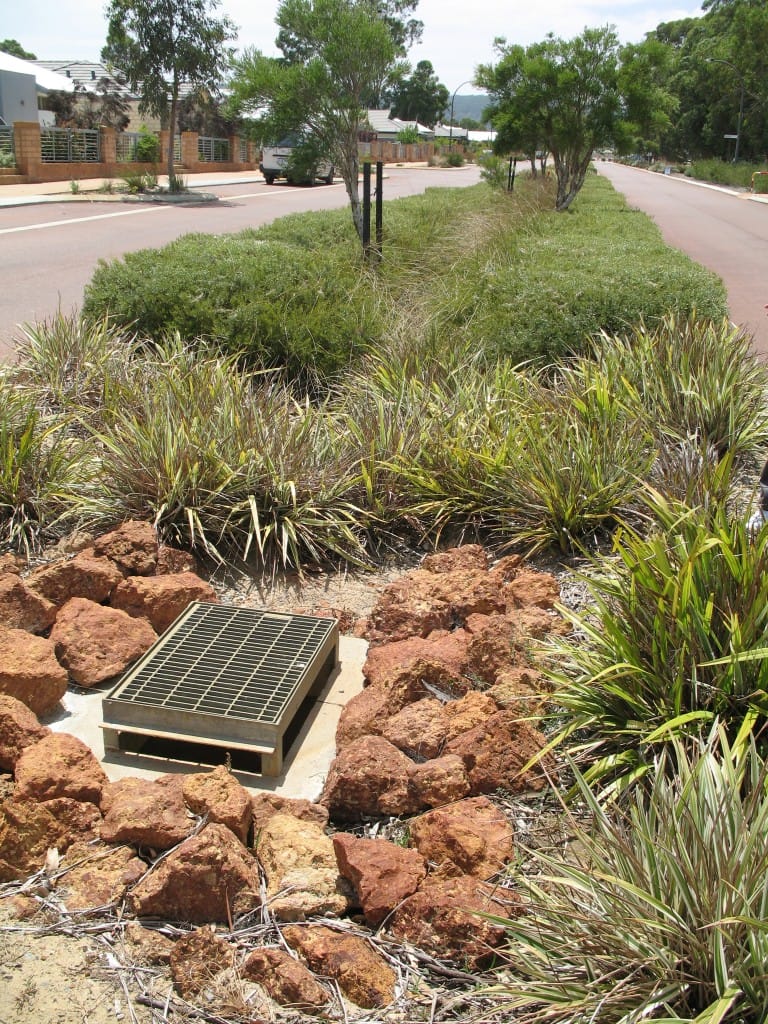Robust research and industry bond guides a new generation of raingardens
Stormwater biofiltration systems – sometimes affectionately known as “raingardens” – are an increasingly popular element of Water Sensitive Urban Design (WSUD). Aside from providing a lovely green space which cools the urban climate and enhances urban biodiversity and habitat, these gardens filter pollutants from local stormwater. This improves waterway health and allows for stormwater harvesting, providing an alternative and local water supply. On the surface these look like regular gardens, but underneath they hide layered materials that work with plants and the microbial community to treat incoming pollutants.

Guidelines for a new generation
Raingardens came onto the scene in Australia around the turn of the millennium. By 2009, Monash University’s Facility for Advancing Water Biofiltration (FAWB) had developed some important guidelines to assist the engineers, planners, landscape architects, constructors, maintenance teams, regulators, and other members of industry involved in the design, construction, and adoption of this significant element of WSUD. Since the publication of these guidelines there has been a great deal of scientific progress, including recently through three research projects at the CRC for Water Sensitive Cities (CRCWSC): Cities as water supply catchments – Sustainable technologies (Project C1.1); Fit-for-purpose water production (Project C1.3); and Integrated multi-functional urban water systems (Project C4.1). The industry has also had a great deal of practical experience with implementing these technologies. Considering this progress, the CRCWSC and its industry partners recognised the need for significant additions to the current adoption guidelines, so Project C1.1 has developed guidelines for a new generation of raingardens.
In addition to revising the guidelines, research into raingardens is continuing to investigate new opportunities. Current raingardens exclusively treat stormwater, which makes them ineffective in dry weather. New research (C4.1) will see them treating stormwater during wet periods and potentially polishing wastewater or polluted groundwater during dry periods: a hybrid technique that would be particularly sustainable for dry climates, such as in Perth.

“Much of the early research was focused on eastern states technology,” says Krish Seewraj, Senior Engineer for the Western Australian Department of Water. “However, the CRCWSC have more recently started testing their theories in a greater variety of conditions, which means the technologies are more adaptable to a range of climates and hydrogeological conditions.” The Department has strongly vested interests in many of the CRCWSC’s practices – given how they perform in WA’s prolonged dry summer periods, and in hydrogeological conditions in which there are significant interactions between surface water and groundwater. “We have conducted prior research”, explains Krish, “which shows that in some areas of WA we could treat 99% of all rainfall through ‘small events’: the level of rainfall which raingardens are ideally suited to handle.”
The benefit of experience
So why do we need a new set of guidelines? “As well as incorporating important new research into the guidelines, we can now include practical advice based on the hands-on experience of our industry partners,” says Dr Belinda Hatt, one of the lead authors for the new guidelines. “We had an industry advisory panel which provided first-hand evidence on what does and does not work, how to address challenging conditions, and what makes a system successful in the long term while minimising maintenance demands.”
“The highly consultative and practical approach undertaken by the researchers was really well managed and worthwhile,” observes Krish, as a member of that advisory panel. “They went to considerable lengths to ensure they talked to the right people, actively listened and engaged, and took on the advice. This level of industry participation has resulted in a really good product.”
The finished product
One significant goal for the new guidelines was to make them more user-friendly. “The full report contains a lot of detailed information and different sections will be relevant for different audiences,” says Belinda, “but we’re also providing a summary report which provides a high-level overview of the key considerations for biofilter design. This summary report allows users to easily find the details that are relevant for them.”
Another crucial aim is to provide a strong case that can influence decision makers toward greater uptake of raingardens. These new guidelines include a thorough business case for the adoption of raingardens, as well as a key section on community-friendly design. “We’re in a period of transition,” explains Krish. “We’re moving away from hard infrastructure and traditional drainage techniques, and shifting to green infrastructure. This doesn’t happen overnight: it’s multigenerational change. People can be uncomfortable with change, especially changing systems and processes with which they have become familiar and confident over a long period.”
A strong case for the many economic, environmental, social, and health benefits of raingardens is central to justifying and supporting this gradual change. “If the community wants it they can be a really important driving force for change,” says Belinda. “Demographics make a big difference,” adds Krish. “Some demographic areas pay less regard to such systems, so there is a greater risk of the systems being damaged; while in other areas people take on a sense of ownership of these systems: weeding and picking up litter.” Designing raingardens to encourage community support will be greatly facilitated by the new guidelines; they give clear advice on landscape design that looks good, as well as other aspects that help to bring the community on board.

There is also “much clearer guidance on vegetation selection: what makes a plant a good plant for optimal treatment performance,” says Belinda. The wider range of options will further encourage improved aesthetic design, as well as enabling greater flexibility and adaptability for different circumstances and locations. “Our group has been successful in taking raingardens to Israel and Singapore, and we are also looking to do some work in Hong Kong and China.”
Staying at the forefront
In Australia, raingardens have become one of the most popular stormwater treatment technologies because they’re so flexible in their size, design, and appearance. “This means they are much more easily slotted into existing urban areas than other treatment technologies,” explains Belinda. With Melbourne Water recently installing 10,000 raingardens across Melbourne, and similar projects being replicated in other parts of the world, this technology is fast becoming a mainstay of WSUD. The firm relationship between CRCWSC researchers and their industry partners has provided both the theoretical and the practical guidance that will ensure the continued rise of the humble raingarden. “I felt quite privileged and proud to be involved in the process,” says Krish.
Sam Green for the Mind Your Way team